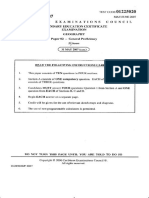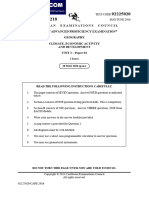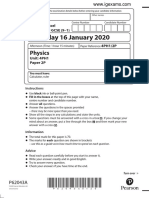E2 5 Data Response Eng-3
E2 5 Data Response Eng-3
Uploaded by
qrincesschengCopyright:
Available Formats
E2 5 Data Response Eng-3
E2 5 Data Response Eng-3
Uploaded by
qrincesschengCopyright
Available Formats
Share this document
Did you find this document useful?
Is this content inappropriate?
Copyright:
Available Formats
E2 5 Data Response Eng-3
E2 5 Data Response Eng-3
Uploaded by
qrincesschengCopyright:
Available Formats
=============================================================
Unit 2 Global climate change
Fundamental
1
[[geoge2drq002
Figure 1 shows the global distribution of annual mean temperature.
Figure 1
Source: 中文百科全書
a. (i) State the latitudes where the annual mean temperature above 20°C and
below -10°C respectively located at. (2)
(ii) Describe the global distribution pattern of annual mean temperature. (2)
b. (i) How will the global distribution of annual mean temperature change in the
future under the influence of climate change? (3)
(ii) How will the changes above affect the agricultural production at location X?
© 2023 Aristo Educational Press Ltd. 1
(2)
Marks: ______ / 9
Advanced
2
[[geoge2drq003
Figure 1 shows the distribution of major climatic zones in the world and the locations
of Lisbon and Cairns. Figure 2 shows the climatic graph of city P. Table 1 shows the
climatic data of city Q from July to December.
Figure 1
Figure 2 Title: _______________________
© 2023 Aristo Educational Press Ltd. 2
Table 1
Month Jul Aug Sep Oct Nov Dec
Temp. (°C) 22.7 22.9 21.7 18.4 14.8 12.4
City Q
Rainfall (mm) 6.1 6.8 28.5 79.8 107.1 121.8
a. Refer to Figure 1.
(i) Identify climatic zones I, II and III. (3)
I:
II:
III:
(ii) Measure the reduced bearing and straight-line distance from Cairns to
Lisbon. (2)
b. Refer to Figure 1, Figure 2 and Table 1.
(i) Using the data in Table 1, complete the climatic graph of city Q in the space
provided. (3)
(ii) Match city P and city Q to Lisbon and Cairns. (2)
(iii) Explain your answers in (b)(ii). (4)
© 2023 Aristo Educational Press Ltd. 3
c. Has a larger temperature change been observed in city P or city Q in recent
decades? Why? (2)
Marks: ______ / 16
=============================================================
Unit 3 Causes of climate change
Figure 1 shows the change in the global carbon dioxide emissions from 1760 to 2020.
Figure 2 shows a human activity.
Figure 1
Source: Global Carbon Project
Figure 2
© 2023 Aristo Educational Press Ltd. 4
a. Refer to Figure 1.
(i) Describe the trend of the change in the global carbon dioxide emissions
from 1760 to 2020. Support your answer with data. (2)
(ii) If the trend above continues, how will global climate change be affected?(2)
b. Refer to Figure 2.
(i) Identify the human activity shown in the figure. (1)
(ii) State how the human activity above has led to the change in (a)(i). (2)
c. What other human activities have led to the change mentioned in (a)(i)? Explain.
(4)
Marks: ______ / 11
##
=============================================================
Unit 4 Impacts of climate change
Fundamental
© 2023 Aristo Educational Press Ltd. 5
3
[[geoge2drq006
Table 1 shows the change in the area of Arctic sea ice in September from 1980 to
2020. Figure 1 is a photo taken in the Arctic region.
Table 1
Year 1980 1990 2000 2010 2020
Area of Arctic sea ice in
754 604 598 462 382
September (10 000 km2)
Source: NASA
Figure 1
a. Refer to Table 1.
(i) Draw a line graph to show the change in the area of Arctic sea ice in
September from 1980 to 2020. (3)
Title: ________________________________________
© 2023 Aristo Educational Press Ltd. 6
(ii) Describe the trend of the change in the area of Arctic sea ice in September
from 1980 to 2020. (1)
(iii) Explain how human activities have led to the change above. (3)
b. Refer to Figure 2.
(i) What is the characteristic of the sea ice shown in the figure? (1)
(ii) How does the characteristic above affect the organism in the figure? (2)
(iii) What positive impacts does it bring? (2)
Marks: ______ / 12
Advanced
4
[[geoge2drq007
Figure 1 shows the locations of Marshall Islands and Great Keppel Island, Australia.
© 2023 Aristo Educational Press Ltd. 7
Figure 2 shows a photo of Marshall Islands. Figure 3 shows problem X faced by Great
Keppel Island.
Figure 1
Figure 2
Figure 3
© 2023 Aristo Educational Press Ltd. 8
a. Refer to Figure 1.
(i) Compare the differences in the locations of Marshall Islands and Great
Keppel Island. (2)
(ii) Measure the whole circle bearing and straight-line distance from Marshall
Islands to Great Keppel Island. (2)
b. Refer to Figure 1 and Figure 2.
(i) Are Marshall Islands easily threatened by sea level rise? Explain with
evidence. (3)
(ii) What are the impacts of sea level rise on local residents? (2)
c. Refer to Figure 3.
(i) Identify problem X. (1)
(ii) Explain the causes of problem X. (3)
© 2023 Aristo Educational Press Ltd. 9
(iii) What are the socio-economic impacts of problem X brought to Australia?(2)
Marks: ______ / 15
]]
=============================================================
Unit 5 Measures against climate change
Fundamental
5
[[geoge2drq008
Figure 1 shows measures I to IV to combat climate change. Figure 2 shows some
information about international agreement Y.
Figure 1
Measure I Measure II
Measure III Measure IV
Figure 2
© 2023 Aristo Educational Press Ltd. 10
International agreement Y
Adopted in 2015
Aims to limit global temperature increase in this century to
no more than 2°C
MDCs should take the lead in cutting emissions and help
LDCs combat climate change by providing financial aid
a. Refer to Figure 1.
(i) Identify measures I to IV. (4)
I:
II:
III:
IV:
(ii) Which measure could not ease climate change? Explain. (3)
b. Refer to Figure 2.
(i) Identify international agreement Y. (1)
(ii) What factors would lower the effectiveness of international agreement Y in
carbon reduction? (3)
Marks: ______ / 11
© 2023 Aristo Educational Press Ltd. 11
You might also like
- CSEC Geo Paper 2 Booklet (2016 - 2023)Document157 pagesCSEC Geo Paper 2 Booklet (2016 - 2023)Tari67% (3)
- Name - Date - : Cambridge Lower Secondary Science 8: Class Test: Unit:5Document5 pagesName - Date - : Cambridge Lower Secondary Science 8: Class Test: Unit:5Neetha Telkar100% (4)
- Cambridge O Level: GEOGRAPHY 2230/01Document12 pagesCambridge O Level: GEOGRAPHY 2230/01Syed Halawi100% (1)
- M1 - Past Papers HKDSE DBQ & EssayDocument32 pagesM1 - Past Papers HKDSE DBQ & Essayczm19101No ratings yet
- Geography Paper 2Document12 pagesGeography Paper 2hikwahaniNo ratings yet
- 2022 Unit 1 P2 GeographyDocument18 pages2022 Unit 1 P2 GeographyKamea GeorgeNo ratings yet
- CAPE Env. Science 2005 U1 P2Document5 pagesCAPE Env. Science 2005 U1 P2Theron SeegobinNo ratings yet
- 2021-2022 Form3 - Hy - Geography - QPDocument12 pages2021-2022 Form3 - Hy - Geography - QPHiiiNo ratings yet
- 2022-23 S6 Geog Mock Paper 2 (EMI)Document13 pages2022-23 S6 Geog Mock Paper 2 (EMI)aimee201068No ratings yet
- CSEC Geography June 2007 P2Document15 pagesCSEC Geography June 2007 P2nam tiddiesNo ratings yet
- WS - Geo - Grade 11B - 18 March 2020Document16 pagesWS - Geo - Grade 11B - 18 March 2020Ebid AlfatikhNo ratings yet
- NSSCO Specimen Geo Apr2006Document64 pagesNSSCO Specimen Geo Apr2006hangerouaraeraNo ratings yet
- University of Cambridge International Examinations General Certifi Cate of Education Advanced Subsidiary Level and Advanced LevelDocument8 pagesUniversity of Cambridge International Examinations General Certifi Cate of Education Advanced Subsidiary Level and Advanced LevelSalman KhalidNo ratings yet
- Y3ip Eoy Paper 1 2020 QNSDocument5 pagesY3ip Eoy Paper 1 2020 QNSng.zor.zayNo ratings yet
- Geography Form 4 Marking SchemeDocument7 pagesGeography Form 4 Marking Schememhandosam94No ratings yet
- S1 - Geography - 19-20 - Final Term - Question PaperDocument9 pagesS1 - Geography - 19-20 - Final Term - Question PaperJoseph LeeNo ratings yet
- 9696 w15 QP 12 PDFDocument8 pages9696 w15 QP 12 PDFShail DarbariNo ratings yet
- GeographyDocument8 pagesGeographyOzan EffendiNo ratings yet
- ESS Paper 1 - PreboardDocument10 pagesESS Paper 1 - PreboardruhaanNo ratings yet
- Geography November 2010 Paper 2Document12 pagesGeography November 2010 Paper 2TANNo ratings yet
- Geography Seminar UACE 2022Document6 pagesGeography Seminar UACE 2022ssemamboisaac7No ratings yet
- Midgea Post Mock 2021 P1QDocument7 pagesMidgea Post Mock 2021 P1QSimon PeterNo ratings yet
- Geography Paper 1 November 2004Document9 pagesGeography Paper 1 November 2004Joshua ZonaNo ratings yet
- Cambridge International Advanced Subsidiary and Advanced LevelDocument4 pagesCambridge International Advanced Subsidiary and Advanced LevelzembedivineNo ratings yet
- GeographyDocument8 pagesGeographyOzan EffendiNo ratings yet
- Geo County Mocks 2006-2014Document146 pagesGeo County Mocks 2006-2014namelessmsaniiNo ratings yet
- Geo Paper 1 Uace EditDocument5 pagesGeo Paper 1 Uace Editjosephatmonday3No ratings yet
- Geography November 2011 Paper 2Document15 pagesGeography November 2011 Paper 2TANNo ratings yet
- ICSE Class 10 Geography 2004Document7 pagesICSE Class 10 Geography 2004Adnan KhanNo ratings yet
- Geo 2 Form 3Document7 pagesGeo 2 Form 3Caspar MundungehamaNo ratings yet
- Geography 2016 U2 P2Document11 pagesGeography 2016 U2 P2leahblanc05No ratings yet
- Geography Random ShitDocument12 pagesGeography Random ShitBacon 【培根】No ratings yet
- 2217 w06 QP 1Document16 pages2217 w06 QP 1mstudy123456No ratings yet
- Geography P1 QNSDocument4 pagesGeography P1 QNSmaxhelion36No ratings yet
- Name - Date - : Cambridge Lower Secondary Science 8: Class Test: Unit:5Document5 pagesName - Date - : Cambridge Lower Secondary Science 8: Class Test: Unit:5Mykhailo MykhailoNo ratings yet
- Icjegypu 13Document8 pagesIcjegypu 13bye.yebaba098No ratings yet
- Cambridge International Advanced Subsidiary and Advanced LevelDocument4 pagesCambridge International Advanced Subsidiary and Advanced LevelkgethilwemakgotsoNo ratings yet
- Geo P2 MSDocument17 pagesGeo P2 MSmarashia1010No ratings yet
- Geography Made FamiliarDocument58 pagesGeography Made Familiarwaiswakeneth4No ratings yet
- Gr8 Geog June 2022 QPDocument10 pagesGr8 Geog June 2022 QPzinhle4sindiswaNo ratings yet
- Geography - Paper - 2 - Question - Booklet - HL May 2017Document11 pagesGeography - Paper - 2 - Question - Booklet - HL May 2017taminhthien2009No ratings yet
- Geography 2015 U2 P2Document9 pagesGeography 2015 U2 P2leahblanc05No ratings yet
- Chemistry 1 Specimen QP Class XiDocument7 pagesChemistry 1 Specimen QP Class Xiuday mishraNo ratings yet
- 2022-23 S6 Geog Mock Paper 1 (EMI)Document22 pages2022-23 S6 Geog Mock Paper 1 (EMI)aimee201068No ratings yet
- Geography Specimen QP Class XiDocument7 pagesGeography Specimen QP Class XiAnkur SarkarNo ratings yet
- S.3 Geog End of Year 2023Document4 pagesS.3 Geog End of Year 2023romazanion397No ratings yet
- Reasoning and Proving Representing Selecting Tools Problem Solving Connecting Reflecting CommunicatingDocument7 pagesReasoning and Proving Representing Selecting Tools Problem Solving Connecting Reflecting CommunicatingmyobNo ratings yet
- Geography November 1994 Paper 2Document5 pagesGeography November 1994 Paper 2TANNo ratings yet
- Geography June 2010 Paper 2Document15 pagesGeography June 2010 Paper 2Nicholas NdambakuwaNo ratings yet
- FORM TP 2012193: Caribbean Examinations CouncilDocument10 pagesFORM TP 2012193: Caribbean Examinations CouncilKaye CampbellNo ratings yet
- Quiz 1 - SSDocument4 pagesQuiz 1 - SScathy63368No ratings yet
- ICSE Class 10 Geography 2003Document7 pagesICSE Class 10 Geography 2003Adnan KhanNo ratings yet
- Enhancement GravitationDocument5 pagesEnhancement GravitationCart KartikaNo ratings yet
- WS - Geo - Grade 11B - 20 March 2020Document10 pagesWS - Geo - Grade 11B - 20 March 2020Ebid AlfatikhNo ratings yet
- 2020-21-S2 GeographyDocument13 pages2020-21-S2 GeographywuhoyinNo ratings yet
- Cambridge International AS & A Level: GEOGRAPHY 9696/11Document4 pagesCambridge International AS & A Level: GEOGRAPHY 9696/11Blessing NgonidzasheNo ratings yet
- CAPE Env. Science 2012 U1 P2Document9 pagesCAPE Env. Science 2012 U1 P2Christina FrancisNo ratings yet
- GCE Ordinary Level Economics Paper 2 2017Document4 pagesGCE Ordinary Level Economics Paper 2 2017metsegouocksolangeNo ratings yet
- History and GeographyDocument8 pagesHistory and GeographyTaryno BBNo ratings yet
- Interactions on Digital Tablets in the Context of 3D Geometry LearningFrom EverandInteractions on Digital Tablets in the Context of 3D Geometry LearningNo ratings yet
- Hist - QB - T3 - 5. NJECNDocument4 pagesHist - QB - T3 - 5. NJECNqrincesschengNo ratings yet
- E2 5 Data Response Eng-4Document26 pagesE2 5 Data Response Eng-4qrincesschengNo ratings yet
- Teacher E2 Ws U3-4.1Document12 pagesTeacher E2 Ws U3-4.1qrincesschengNo ratings yet
- Hist - QB - T1 - 3. NJETNDocument5 pagesHist - QB - T1 - 3. NJETNqrincesschengNo ratings yet
- Hist SN T4 e STDocument37 pagesHist SN T4 e STqrincesschengNo ratings yet
- 科学一年级上学期Document1 page科学一年级上学期qrincesschengNo ratings yet
- 科学一年级上学期 4Document1 page科学一年级上学期 4qrincesschengNo ratings yet
- Biosphere ReservesDocument22 pagesBiosphere Reservesnitesh kumarNo ratings yet
- Fresnel Lens - Solar EnergyDocument16 pagesFresnel Lens - Solar Energynikhil.chotaiNo ratings yet
- VIVA V12 MF BatteryDocument2 pagesVIVA V12 MF BatteryojoladapoNo ratings yet
- Science 9 Summative Test 2Document3 pagesScience 9 Summative Test 2Ma. Socorro Hilario50% (2)
- Sunburst Park IloiloDocument4 pagesSunburst Park IloiloMia Pauline Farillon LeeNo ratings yet
- Solar Photovoltaic Based Water Electrolysis System To Generate Hydrogen and OxygenDocument11 pagesSolar Photovoltaic Based Water Electrolysis System To Generate Hydrogen and OxygenIJRASETPublicationsNo ratings yet
- Middle Benue Trough Group 5 Document RepairDocument37 pagesMiddle Benue Trough Group 5 Document RepairBryan IsraelNo ratings yet
- Plate Tectonics TheoryDocument8 pagesPlate Tectonics TheoryWendelyn Sumpo100% (1)
- Chapter 7 Nuclear PlantDocument37 pagesChapter 7 Nuclear PlantCandice PeñaNo ratings yet
- Neet Ug Paper Analysis 2022Document8 pagesNeet Ug Paper Analysis 2022AjNo ratings yet
- Biomass Briquette: Aramco Project ProposalDocument5 pagesBiomass Briquette: Aramco Project ProposalHeartwell Bernabe Licayan100% (1)
- Hot Oil Systems: Chris FinchDocument14 pagesHot Oil Systems: Chris FinchHuzefa ArsiwalaNo ratings yet
- Topic 3 AnswersDocument5 pagesTopic 3 AnswersHarani ThillainathanNo ratings yet
- Stoich PDFDocument13 pagesStoich PDFJesza Mei GanironNo ratings yet
- Lec. 1 AdsorptionDocument27 pagesLec. 1 AdsorptionIqra MubeenNo ratings yet
- Effect of Bagasse Ash Filled Epoxy Composites Reinforced With Hybrid Plant Fibres ForDocument20 pagesEffect of Bagasse Ash Filled Epoxy Composites Reinforced With Hybrid Plant Fibres ForIsmadi IsmadiNo ratings yet
- Work Energy Power StructuredDocument4 pagesWork Energy Power Structuredlogan bain100% (1)
- STM PresentationDocument22 pagesSTM PresentationPritish MoharirNo ratings yet
- 1J11.50 Double Cone On An InclineDocument5 pages1J11.50 Double Cone On An Inclinesuman dahalNo ratings yet
- Bubble Power ReportDocument23 pagesBubble Power ReportSenthil Kumar100% (1)
- Seabed Prehistory: Area 240 - ExhibitionDocument5 pagesSeabed Prehistory: Area 240 - ExhibitionWessex ArchaeologyNo ratings yet
- Fuelcell PDFDocument33 pagesFuelcell PDFKodanda RamaraoNo ratings yet
- AQA IGCSE Chemistry SpecificationDocument47 pagesAQA IGCSE Chemistry SpecificationlxyshjphoebeNo ratings yet
- Che 126 - (Prof Woods and Dr. Omoreghie's Part)Document541 pagesChe 126 - (Prof Woods and Dr. Omoreghie's Part)BishopNo ratings yet
- Sulfuric Acid Production in Kazakhstan, StepnogorskDocument4 pagesSulfuric Acid Production in Kazakhstan, StepnogorskErj DaniyaroffNo ratings yet
- IGCSE Physics-Past Paper - Jan 20 Paper 2P (QP)Document20 pagesIGCSE Physics-Past Paper - Jan 20 Paper 2P (QP)Paing Khant KyawNo ratings yet
- Syllabus For Fixed Term Associates-1Document7 pagesSyllabus For Fixed Term Associates-1Khan KhursheedNo ratings yet
- Budge Budge Institute of TechnologyDocument9 pagesBudge Budge Institute of TechnologyPRIYA BERANo ratings yet
- Hidroturbinas en Brazil. - Tiago FilhoDocument2 pagesHidroturbinas en Brazil. - Tiago Filhodm311No ratings yet
- A Dual Nature of LightDocument2 pagesA Dual Nature of LightRoshdy WaheedNo ratings yet
































































































